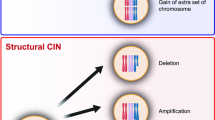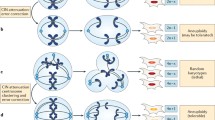Abstract
Chromosomal instability (CIN) distinguishes invasive urothelial carcinomas from less malignant papillary subtypes. Recent results implicate checkpoint dysfunction as a crucial factor underlying the emergence of aneuploidy in urothelial carcinogenesis. It may moreover contribute to DNA repair defects. Therefore, defects in cell cycle regulation, p53 function, and checkpoint signaling initially caused by carcinogens in the urothelium could ultimately elicit CIN. Among several mechanisms contributing to aneuploidy, breakage-fusion-bridge (BFB) cycles initiated by defective telomeres may be particularly relevant. The mechanism generating large interstitial deletions, prominently at 9p21, appears to be distinct. New experimental approaches are required to address important unresolved questions such as the precise relationship between telomere erosion and telomerase activation, the influence of checkpoint defects on DNA double-strand repair by non-homologous and homomologous recombination repair systems, and the mechanism responsible for megabase-sized interstitial deletions.



Similar content being viewed by others
References
Agrelo R, Cheng WH, Setien F et al (2006) Epigenetic inactivation of the premature aging Werner syndrome gene in human cancer. Proc Natl Acad Sci USA 103:8822–8827
Akyüz N, Boehden GS, Süsse S et al (2002) DNA substrate dependence of p53-mediated regulation of double-strand break repair. Mol Cell Biol 22:6306–6317
Bartkova J, Horejsí Z, Koed K et al (2005) DNA damage response as a candidate anti-cancer barrier in early human tumorigenesis. Nature 434:864–870
Bartkova J, Rezaei N, Liontos M et al (2006) Oncogene-induced senescence is part of the tumorigenesis barrier imposed by DNA damage checkpoints. Nature 444:633–637
Baskin LS, Hayward SW, Sutherland RA et al (1997) Cellular signaling in the bladder. Front Biosci 2:592–595
Bentley J, Diggle CP, Harnden P, Knowles MA, Kiltie AE (2004) DNA double strand break repair in human bladder cancer is error prone and involves microhomology-associated end-joining. Nucleic Acids Res 32:5249–5259
Berwick M, Vineis P (2000) Markers of DNA repair and susceptibility to cancer in humans: an epidemiologic review. J Natl Cancer Inst 92:874–897
Burger M, Burger SJ, Denzinger S et al (2006) Elevated microsatellite instability at selected tetranucleotide repeats does not correlate with clinicopathologic features of bladder cancer. Eur Urol 50:770–775
Burwinkel B, Kilimann MW (1998) Unequal homologous recombination between LINE-1 elements as a mutational mechanism in human genetic disease. J Mol Biol 277:513–517
Catto JW, Azzouzi AR, Amira N et al (2003) Distinct patterns of microsatellite instability are seen in tumours of the urinary tract. Oncogene 22:8699–8706
Chen L, Huang S, Lee L et al (2003) WRN, the protein deficient in Werner syndrome, plays a critical structural role in optimizing DNA repair. Aging Cell 2:191–199
Christmann M, Tomicic MT, Roos WP, Kaina B (2003) Mechanisms of human DNA repair: an update. Toxicology 193:3–34
Corbin S, Neilly ME, Espinosa R 3rd et al (2002) Identification of unstable sequences within the common fragile site at 3p14.2: implications for the mechanism of deletions within fragile histidine triad gene/common fragile site at 3p14.2 in tumors. Cancer Res 62:3477–3484
Coquelle A, Toledo F, Stern S, Bieth A, Debatisse M (1998) A new role for hypoxia in tumor progression: induction of fragile site triggering genomic rearrangements and formation of complex DMs and HSRs. Mol Cell 2:259–265
Cox C, Bignell G, Greenman C et al (2005) A survey of homozygous deletions in human cancer genomes. Proc Natl Acad Sci USA 102:4542–4547
Crallan RA, Georgopoulos NT, Southgate J (2006) Experimental models of human bladder carcinogenesis. Carcinogenesis 27:374–381
Eble JN, Sauter G, Epstein JI, Sesterhenn IA (2004) Pathology and genetics of tumours of the urinary system and male genital organs. IARC Press, Lyon
Ferlay J, Bray F, Pisani P et al (2004) Globocan 2002: Cancer incidence, mortality and prevalence worldwide. IARC Cancer Base No.5 version 2.0
Figueroa JD, Malats N, Real FX et al (2007a) Genetic variation in the base excision repair pathway and bladder cancer risk. Hum Genet 121:233–242
Figueroa JD, Malats N, Rothman N et al (2007b) Evaluation of genetic variation in the double-strand break repair pathway and bladder cancer risk. Carcinogenesis 28:1788–1793
Florl AR, Schulz WA (2003) Peculiar structure and location of 9p21 homozygous deletion breakpoints in human cancer cells. Genes Chromosomes Cancer 37:141–148
Florl AR, Löwer R, Schmitz-Dräger BJ, Schulz WA (1999) DNA methylation and expression of LINE-1 and HERV-K provirus sequences in urothelial and renal cell carcinomas. Br J Cancer 80:1312–1321
Florl AR, Franke KH, Niederacher D et al (2000) DNA methylation and the mechanisms of CDKN2A inactivation in transitional cell carcinoma of the urinary bladder. Lab Invest 80:1513–1522
García-Closas M, Malats N, Real FX et al (2006) Genetic variation in the nucleotide excision repair pathway and bladder cancer risk. Cancer Epidemiol Biomarkers Prev 15:536–542
Gisselsson D (2003) Chromosome instability in cancer: how, when, and why? Adv Cancer Res 87:1–29
Grollman AP, Shibutani S, Moriya M et al (2007) Aristolochic acid and the etiology of endemic (Balkan) nephropathy. Proc Natl Acad Sci USA 104:12129–12134
Hartmann A, Dietmaier W, Hofstädter F et al (2003) Urothelial carcinoma of the upper urinary tract: inverted growth pattern is predictive of microsatellite instability. Hum Pathol 34:222–227
Jasin M (1996) Genetic manipulation of genomes with rare-cutting endonucleases. Trends Genet 12:224–228
Jin Y, Stewénius Y, Lindgren D et al (2007) Distinct mitotic segregation errors mediate chromosomal instability in aggressive urothelial cancers. Clin Cancer Res 13:1703–1712
Kitagawa Y, Inoue K, Sasaki S et al (2002) Prevalent involvement of illegitimate V(D)J recombination in chromosome 9p21 deletions in lymphoid leukemia. J Biol Chem 277:46289–46297
Knowles MA (2006) Molecular subtypes of bladder cancer: Jekyll and Hyde or chalk and cheese? Carcinogenesis 27:361–373
Kohno T, Yokota J (2006) Molecular processes of chromosome 9p21 deletions causing inactivation of the p16 tumor suppressor gene in human cancer: deduction from structural analysis of breakpoints for deletions. DNA Repair (Amst) 5:1273–1281
Lacey KR, Jackson PK, Stearns T (1999) Cyclin-dependent kinase control of centrosome duplication. Proc Natl Acad Sci USA 96:2817–2822
Lengauer C, Kinzler KW, Vogelstein B (1998) Genetic instabilities in human cancers. Nature 396:643–649
Liang L, Deng L, Chen Y et al (2005) Modulation of DNA end joining by nuclear proteins. J Biol Chem 280:31442–31449
Lin Y, Miyamoto H, Fujinami K et al (1996) Telomerase activity in human bladder cancer. Clin Cancer Res 2:929–932
López-Knowles E, Hernández S, Malats N et al (2006) PIK3CA mutations are an early genetic alteration associated with FGFR3 mutations in superficial papillary bladder tumors. Cancer Res 66:7401–7404
McDermott KM, Zhang J, Holst CR et al (2006) p16(INK4a) prevents centrosome dysfunction and genomic instability in primary cells. PLoS Biol 4:e51
Meeker AK, Hicks JL, Iacobuzio-Donahue CA et al (2004) Telomere length abnormalities occur early in the initiation of epithelial carcinogenesis. Clin Cancer Res 10:3317–3326
Mimori K, Druck T, Inoue H et al (1999) Cancer-specific chromosome alterations in the constitutive fragile region FRA3B. Proc Natl Acad Sci USA 96:7456–7461
Mohrenweiser HW, Jones IM (1998) Variation in DNA repair is a factor in cancer susceptibility: a paradigm for the promises and perils of individual and population risk estimation? Mutat Res 400:15–24
Neveling K, Kalb R, Florl AR et al (2007) Disruption of the FA/BRCA pathway in bladder cancer. Cytogenet Genome Res 118:166–176
Nortier JL, Martinez MC, Schmeiser HH et al (2000) Urothelial carcinoma associated with the use of a Chinese herb (Aristolochia fangchi). N Engl J Med 342:1686–1692
Olfert SM, Felknor SA, Delclos GL (2006) An updated review of the literature: risk factors for bladder cancer with focus on occupational exposures. South Med J 99:1256–1263
Oshima J, Huang S, Pae C, Campisi J, Schiestl RH (2002) Lack of WRN results in extensive deletion at nonhomologous joining ends. Cancer Res 62:547–551
Padilla-Nash HM, Heselmeyer-Haddad K, Wangsa D et al (2001) Jumping translocations are common in solid tumor cell lines and result in recurrent fusions of whole chromosome arms. Genes Chromosomes Cancer 30:349–363
Raschke S, Balz V, Efferth T, Schulz WA, Florl AR (2005) Homozygous deletions of CDKN2A caused by alternative mechanisms in various human cancer cell lines. Genes Chromosomes Cancer 42:58–67
Ruas M, Peters G (1998) The p16INK4a/CDKN2A tumor suppressor and its relatives. Biochim Biophys Acta 1378:F115–F177
Sasaki S, Kitagawa Y, Sekido Y et al (2003) Molecular processes of chromosome 9p21 deletions in human cancers. Oncogene 22:3792–3798
Sato M, Sasaki H, Kazui T, Yokota J, Kohno T (2005a) Probing the chromosome 9p21 region susceptible to DNA double-strand breaks in human cells in vivo by restriction enzyme transfer. Oncogene 24:6108–6118
Sato M, Takahashi K, Nagayama K et al (2005b) Identification of chromosome arm 9p as the most frequent target of homozygous deletions in lung cancer. Genes Chromosomes Cancer 44:405–414
Schulz WA (2006) Understanding urothelial carcinoma through cancer pathways. Int J Cancer 119:1513–1518
Seifert HH, Meyer A, Cronauer MV et al (2007) A new and reliable culture system for superficial low-grade urothelial carcinoma of the bladder. World J Urol 25:297–302
Shaffer LG, Lupski JR (2000) Molecular mechanisms for constitutional chromosomal rearrangements in humans. Annu Rev Genet 34:297–329
Stern MC, Umbach DM, van Gils CH, Lunn RM, Taylor JA (2001) DNA repair gene XRCC1 polymorphisms, smoking, and bladder cancer risk. Cancer Epidemiol Biomarkers Prev 10:125–131
Stern MC, Umbach DM, Lunn RM, Taylor JA (2002) DNA repair gene XRCC3 codon 241 polymorphism, its interaction with smoking and XRCC1 polymorphisms, and bladder cancer risk. Cancer Epidemiol Biomarkers Prev 11:939–943
Swiatkowski Seifert HH, Steinhoff C et al (2003) Activities of MAP-kinase pathways in normal uroepithelial cells and urothelial carcinoma cell lines. Exp Cell Res 282:48–57
Taniguchi T, Tischkowitz M, Ameziane N et al (2003) Disruption of the Fanconi anemia-BRCA pathway in cisplatin-sensitive ovarian tumors. Nat Med 9:568–574
Tarapore P, Horn HF, Tokuyama Y, Fukasawa K (2001) Direct regulation of the centrosome duplication cycle by the p53-p21Waf1/Cip1 pathway. Oncogene 20:3173–3184
Tort F, Bartkova J, Sehested M et al (2006) Retinoblastoma pathway defects show differential ability to activate the constitutive DNA damage response in human tumorigenesis. Cancer Res 66:10258–10263
van Rhijn BW, Vis AN, van der Kwast TH et al (2003) Molecular grading of urothelial cell carcinoma with fibroblast growth factor receptor 3 and MIB-1 is superior to pathologic grade for the prediction of clinical outcome. J Clin Oncol 21:1912–1921
Varga T, Aplan PD (2005) Chromosomal aberrations induced by double strand DNA breaks. DNA Repair (Amst) 4:1038–1046
Weir BA, Woo MS, Getz G et al (2007) Characterizing the cancer genome in lung adenocarcinoma. Nature 450:893–898
Windhofer F, Krause S, Hader C, Schulz WA, Florl AR (2008) Distinctive differences in DNA double-strand break repair between normal urothelial and urothelial carcinoma cells. Mutat Res 638:56–65
Wu X, Amos CI, Zhu Y et al (2003) Telomere dysfunction: a potential cancer predisposition factor. J Natl Cancer Inst 95:1211–1218
Wu X, Gu J, Grossman HB et al (2006) Bladder cancer predisposition: a multigenic approach to DNA-repair and cell-cycle-control genes. Am J Hum Genet 78:464–479
Wu XR (2005) Urothelial tumorigenesis: a tale of divergent pathways. Nat Rev Cancer 5:713–725
Yu CE, Oshima J, Fu YH et al (1996) Positional cloning of the Werner’s syndrome gene. Science 272:258–262
Acknowledgments
Work in our group on this topic was financially supported by the Deutsche Forschungsgemeinschaft.
Author information
Authors and Affiliations
Corresponding author
Rights and permissions
About this article
Cite this article
Florl, A.R., Schulz, W.A. Chromosomal instability in bladder cancer. Arch Toxicol 82, 173–182 (2008). https://doi.org/10.1007/s00204-008-0280-3
Received:
Accepted:
Published:
Issue Date:
DOI: https://doi.org/10.1007/s00204-008-0280-3




